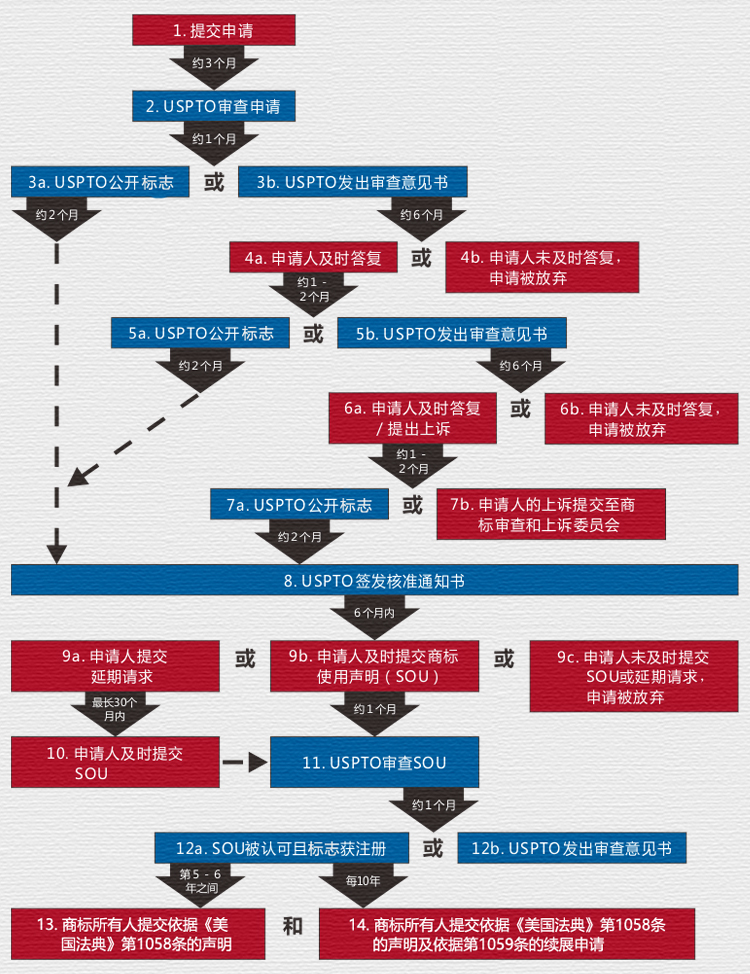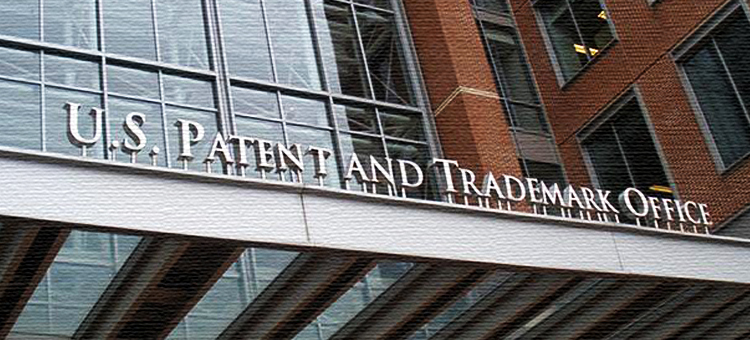Trademark Insurance Guard
According to US law, trademarks are any words, phrases, symbols, design or their combinations for identifying goods or services, including commodity trademarks, services, services, services, services Trademarks, collective trademarks and certification trademarks.
Traditionally, the trademark rights in the United States are first established by using a logo on a specific product or service. These rights are called \"ordinary law\" rights. Ordinary legal rights can only be enjoyed in the geographical area that actually uses the logo, and it does not automatically enjoy the protection of the United States nationwide.
Federal trademark registration has the effectiveness of prefining rights in the country and predefined nationwide. The federal registration of the application for trademarks does not require the trademark to be used. It is only possible to use it, but before the trademark is officially approved, the official will give a certain period of time, request the applicant to use it, and provide corresponding use of evidence. Otherwise, the registration will not be approved to be approved. Essence
UNITED (UNITED States Patent and Trademark Office (USPTO) was established in 1802. It is an important organ in charge of the national patent and trademark applications and approval procedures in the United States. The main responsibility of USPTO is to provide patent protection, trademark registration and intellectual property rights for inventors and their relevant invention.
■
网站:www.uspto.gov
■地址:USPTO Madison Building, 600 Dulany Street, Alexandria, VA 22314(总部, Virginia, Alexander City)
■Tel: 1-800-786-9199 (free business consultation), working hours: Monday to Friday, 8th in the East of the United States 8 am 8 AM in the morning of the United States 8th 8th in the morning of 8. Eastern American : 30 to 8:00 pm, except for the US holidays
■email: ebc@uspto.gov
2. Introduction 
 The use of US trademark rights in the first principle
The use of US trademark rights in the first principle
American trademark The method follows the principle of use first,That is to say, whoever uses first will give priority to the trademark right, which can oppose the confusion of the same or similar trademark. The 15th editors of the American Code \"Commerce and Trade\" Chapter 22 \"Trademark\" (that is, \"Lanham Law\") Article 1057 (B) and (C) stipulates :
(b) Registration certificate as a superficial
(prima facie)
EvidenceRegistration of trademarks on the main registered book established in accordance with this law, registered, registered,, registered in the main registration book established in this law, register It should be the evidence of the validity of the registered trademark and the establishment of the trademark registration surface; it is also the evidence of the surface of the registered trademark ownership; at the same time, it is the condition and restrictions listed in the registered certificate in the business activity according to the registered certificate. Or use evidence on the surface of the dedicated right of the registered trademark on the service item.
(C) The registration application of trademarks is deemed to be presented
According to the provisions of this law on the registered trademark on the main registration book, the registration application of a trademark should constitute Posted on trademarks, grant it to the registered goods or services to effectively preferential priority in the country to fight against others. But except for people with the following situations, his trademark has not been abandoned, and before the application is submitted (1), the trademark has been used; A trademark registration application is waiting for review or approved registration; or
(3) has submitted an application for foreign trademark registration, so as to obtain priority, and in accordance with Article 1126 (D) of this Law The model is submitted to the trademark registration application in a timely manner, and is waiting for review or approved registration.
The right holders who have used the same or similar trademarks that have been used before submitting a trademark registration can oppose the registration of federal trademarks or the infringement claim of the federal registered trademark.
Federal trademark registration has the effectiveness of prefining rights in the country and predefined nationwide. The federal registration of the application for trademarks does not require the trademark to be used. It is only possible to use it, but before the trademark is officially approved, the official will give a certain period of time, request the applicant to use it, and provide corresponding use of evidence. Otherwise, the registration will not be approved to be approved. Essence
The main auxiliary book system for Federal trademark registration
U.S. law regulations can select the main book registration or auxiliary book registration when registering for federal trademarks.
The main book registration of the trademark
Getting trademark registration on the USPTO's Principal Register will provide the best protection for defending the brand. Register in the main bookThere are many benefits, mainly including:
(1) After the trademark is approved, it is presented that the registrar has used the trademark nationwide since submitting the application of trademark registration; (2) Pume the effectiveness of the trademark, the ownership of the registrar to the trademark, and the registered owner's exclusive right to use the logo nationwide on the designated products and services;
(3) Or the scope of the use of similar trademarks, that is, other or similar trademark owners can only apply their own trademarks within the original range;(4) After the trademark is allowed to register, no one can use The same or approximate trademark;
(5) Get the forbidden relief and benefits, damage and cost compensation in the federal court lawsuit, and increase damage compensation and lawyer costs in some cases;
[[
[ 123] (6) Get the right to register for registration in the US Customs and Border Protection to monitor and prevent imports of products with infringement signs;(7) Forgery of registered trademarks, criminal Penalty.
But not all signs can be registered in the main book. The applicable trademark conditions for the main book registration are: the trademark itself is significant; ]*
, which can identify the source of goods or services.
*
\u0026 nbsp; The \"second meaning\" of trademark refers to the universal name, graphics, model, quality, main ingredients, function, use, weight, quantity, quantity, quantity, quantity, quantity, and quantity of directly expressing goods or services. Narrative text, graphics, etc. of the characteristics of the place of origin, or its combination, after long -term use, the original narrative meaning has a new meaning in which the original narrative meaning is marked with the specific source of the product or service. Significant is the essential characteristics of trademarks. Compared with the prominentness of trademarks, the second meaning of the trademark is to obtain the significance of the trademark through the use of the use of trademarks. It is actually transformed from narrative text or graphics that is prohibited as trademarks, and is a commercial symbol beyond the protection of traditional trademark laws.
Article 1052 of the Lanham Law stipulates that the logo of trademark registration cannot be registered directly on the main book, mainly includes: (1) the main and the symbol of only surnames ;
(2) Symbols that are similar to the trademarks registered or used first and will cause consumers to be confused; 123] (4) Deception symbol;
(5) descriptive logo;(6) to indicate the geographical sign of wine or liquor origin, but related wines and Liquor is not native to the area shown in the geographical indication;
(7) The flags, military uniforms, and badges of the United States or states or cities, or foreign governments;
(8) The signs of any living individual name, portrait or signature, Unless you get the written consent of the person;
(9) When the widow is alive, it contains the name, signature or portrait of any late US president, unless the written consent of the widow is obtained.
2. The difference between the auxiliary book registration of the trademark
The difference between the registration and the auxiliary book registration is mainly on significant requirements. Some logos, such as surnames and descriptive signs, although currently not recognizable, may obtain a second meaning through substantial use and promotion, and can be registered on the supportmental register.
Although the trademark registered through the auxiliary book cannot enjoy legitimate effectiveness and possession of ownership like the trademark registered through the main book, it is still good to register Avoid other similar trademarks that are easy to confuse for subsequent registration;
(2) The basis for submitting foreign trademark applications;
(3) The owner can cooperate with the trademark to use registration and register Symbol \"® \".
The trademark for the registration of auxiliary book must be the trademark that the applicant has used. If the trademark has reached a continuous exclusive use and promotion to a certain extent, it makes it easy for the relevant purchasing groups to associate the goods or services with the trademark with the single source, and you can apply for the main book registration. As long as a trademark has reached the substantive exclusive use of a consecutive year and provides relevant proof, USPTO can accept sufficient evidence of identification. However, it is necessary to submit additional evidence such as sales reports, advertising costs, advertising and publicity materials, as well as evidence of consumers' recognition of trademarks such as consumer testimony and investigation reports.
Trademark Renewal
After the trademark registered in USPTO, during the 5-6 years after the registration day, everyone must submit a statement to USPTO to confirm that the registration is registered for registration All the products or services covered with their trademarks in the United States are using their trademarks.
Those who have been over for 10 years from the registration date shall be renewed, and the exhibition will be continued every 10 years. The 10 -year renewal application must include a statement, claiming that the trademarks are used in the American business field for the products and services listed in the United States; and for various products and services, the statement must be attached to at least one use sample.
3. Program
According to USPTO's latest regulations, in addition to a few exceptions, the US trademark registration application after February 15, 2020 must be submitted in an electronic manner, that is, the Teasi for international applications through the trademark electronic application system.
Since August 3, 2019, according to the provisions of USPTO, if it is a partner of a trademark applicant, registrar or trademark trial and appeal committee procedure, it must hire an agency related to the American practice lawyer business. Trademark applicants, registrars, or parties that \"residences outside the United States\" refer to those who do not have a residence in the United States or their territory. Personal residence is where the person lives and intends to become the main residence of the person. The physical residence is the main business location (headquarters) of the senior managers of the entity usually command and control the entity activities.
Submit the application for the application directly to USPTO  Select trademarks and commodities / services
Select trademarks and commodities / services 
(1) the trademark and form to be registered, that is, only words, style words (style) (Stylized wording) And / or design, or sound logo.
Motion or multimedia logo itself must not be submitted as files that show the actual application intention. Although it is an acceptable \"SPECIMEN\", it is not allowed to be applied as a sign of the application. According to US regulations [37 C.F.R. §2.52 (b) (3)], if the sign contains dynamic images, the business impression of the trademark is the best description of the trademark. To show each point in exercise. Applicants must also describe the trademark.
(2) Commodity or services used (or use) trademarks.
2. After searching the USPTO database
After selecting the trademark, the applicant shall use the trademark electronic retrieval system (TESS) to retrieve the USPTO database to determine whether there is a similar trademark that is used for related products and / or services that is easily confusing. Registered or submitted for application.Note that after searching the USPTO database, even if the applicant gets \"O.K.\", don't assume that the trademark can be registered. After the application is submitted, USPTO will also conduct its own retrieval and legal review, and may refuse to register the trademark.
The complete list of possible substantial rejection and its detailed explanation, please refer to Chapter 1200, \"Trademark Review Procedure Manual (TMEP, Current Version: July 2021 Edition)\".
USPTO cannot provide preliminary legal opinions on whether it will approve a specific trademark, and submitting a trademark registration application is the approval of the USPTOThe only way to decide or reject the decision.
3. Check the status of trademarks to avoid potential conflicts
According to the search results of TESS, the applicant should check any state of application or registration that may have conflicts through the trademark status and document search system (TSDR).According to all the above information, the applicant needs to re -evaluate whether the registration is meaningful. Please note that once the application is submitted, USPTO will not cancel the application or refund fee, unless the application fails to meet the minimum application requirements. Even after the examiner conducted a substantial review, the trademark was not registered, and USPTO would not refund the application fee.
4. Create a JPG image
(only used for style or design)If the sign to be registered includes style or design, the applicant first needs to create a JPG (USPTO unique USPTO can be available Acceptable format) image files and store on local computers. Similarly, if the applicant is based on actual commercial purposes -that is, the sales of goods or services that have already sold goods or provide services under this specific trademark -submitting the application, then the \"sample\" (such as the label or service advertisement posted on the product) to be created and used) JPG or PDF image files, that is, the actual appearance of the logo taken by scanning or digital.
Note: The image file that lacks the sample will not hinder the submission of the initial application through the Teas Standard application form, but the Teas Plus application form will not accept the use of the accessory based on the use of attachments in the \"SPECIMEN\" field. Transmission of the application form.
5. Preparing for application fee
In the initial application form of Teas, there are two filing options: Teas Plus and Teas Standard.
The application fee for the initial commodity / service trademark application is: each type of goods / services listed using the Teas Plus application options 250 US dollars, and each category of each type of Teas Standard. (Update time: March 2022, the amount is subject to the trademark cost table.)
For Teas Plus, you need to pay for each category when submitting the application. For Teas Standard, you only need to pay a category fee first, but you must submit all other additional expenses before applying for approval.
6. Online submission application
You can submit the Teas application form through USPTO's online application (Apply Online) page. In the Trademark Initial Application Form) On the page, you provide links to the two main options for the application: (1) Teas Plus; and (2) Teas Standard.
The steps to fill in Teas Standard are almost the same as the steps of Teas Plus. The main difference is that more fields must be filled in in Teas Plus, and the Teas Plus application needs to select products / service categories from USPTO's category manuals. Not the \"free text\" entry allowed in Teas Standard. 根据现行的TMEP,通过TEAS Plus只能提出主簿注册,申请人需要: (1)使用TEAS Plus表格提交完整的申请; ( 2) I agree to submit some communication related to the application through Teas, such as answers to review opinions; and(3) Agree with email receiving relevant applications.
At the same time, Teas Plus requires the application file to include the following content:(1) the name and address of the applicant;
(2) the applicant's legal entity of the applicant's legal person entity (Legal Entity) and CitizenShip proof;
(3) the name and address of the receiving paper letter (Paper CorresPondense);
(4) Email address and authorization address and authorization address and authorization ——In USPTO sending the letter to the applicant's email address and authorization through email;
[5) Apply for the basis or foundation (Filing Basis or Bases); ) Commodity / service classification (Identification) and Classification -must be able to select the correct commodity / service / service / service / service / service / service / service / service / service / service \" Category
, otherwise you can only select Teas Standard to apply;(7) Application fee;
(8) Signature verification (Signed Verification);
(9) Drawing (drawing);
(10) color statement and color description;
(11) trademark description (Description of Mark) — If the trademark does not not是标准字符,需提供商标说明; (12)相同商标的在先注册(Prior Registrations for Same Mark); (13)翻译——如果商标包含外国文字, Provide the translation of this text;
(14) the transliteration of the non -Latin characters -if the trademark contains non -Laidin characters, the transliteration of these characters is provided; [15) registered name or portrait consent Consent to registration of name or portrait -if the trademark contains someone's name or portrait, it can be: (a) the name or portrait registered in the statement belongs to the individual of a certain life and provides the person's written consent of the person's written consent Books; or (b) the name or portrait registered in the statement does not involve individuals in the world;
(16) coexist (Concurrent Use, refers to two or more applicants who have no connected applicants to apply to USPTO to register for registration In the same trademark, each party's registration is limited to different specific business channels or regions);
(17) Multi-category application (Multiple-Class Applications);
(18) According to according to Article 44 of the United States \"1946 Trademark Law\" (ie, Chapter 1526 of the U.S. Code) (Section 44 Applications) -Addowing for international applications, the goods covered by the US trademark registration application submitted by foreign applicants / Service categories cannot exceed the category covered by foreign trademark applications or registered certificates submitted first.
If the applicant selects the Teas Plus application, but the document cannot meet the requirements, the examiner will issue a review opinion, asking the applicant STANDARD application processing follow -up procedures.
When the application file is submitted, Teas will immediately display a \"Success\" page to confirm that the USPTO has received the file. If you have any questions about the application date, this page can be used as evidence to submit the application and can be replicated and pasted in electronic records for storage. Teas will also send a separate electronic confirmation email, which contains the abstract and general program information of the application information. Applicants or acting lawyers should immediately check the summary to ensure accuracy.
7. Tracking application status
After submitting the application for 5-7 days, the application status of the application application can be tracked through the TSDR system. Before the original file was uploaded to the USPTO database, the applicant should not trySubmit the \"Voluntary Amentment\" through the online system.
During the application period, the applicant was responsible for checking the application status at least every 3-6 months between the date of submission and the registration date.
8. Response review opinions
If the trademark application meets the minimum requirements, USPTO will dispatch an examiner for the application. The examiner will determine whether the application is a trademark allowed to register for the federal regulations.
If the application is rejected or a request needs to be further satisfied, the examiner will send the applicant to an OFFICE ACTION. Within 6 months after the review of the review opinion, the applicant must submit the response opinion to explain the reasons for each rejection and the requirements that have not been met.
If the applicant responds to the review opinion within 6 months, the application will be abandoned. Give up, refers to the termination of the application procedure and the trademark will not be registered. If the application is abandoned, the application fee will not be refunded. If the applicant wants to continue the application, the request to submit a re -examination application within 2 months after the application is abandoned; if the request is not submitted within 2 months, the trademark application and pay the corresponding fee.
In order to avoid being abandoned by the application, the applicant must submit the response opinions in time and explain each rejection reason and / or unsatisfactory requirements in the review opinion. The reviewer reviews the response opinion and determines whether the reasons or requirements have been rejected or met. If the applicant fails to successfully answer the review of the review, the examiner will issue a \"final\" rejection of opinion, indicating that there is still rejection of rejection or unsatisfactory requirements. Applicants can respond to the final review opinion, or appeal to trademark review and the TRADEMARK TRIARK TRIAL and APPEAL BOARD (TTAB).
If the applicant responded to the final review opinion within 6 months and did not submit an appeal of the APPEAL to the TTAB, the application would be abandoned. If the applicant wants to continue the application, the request to submit the re -examination application within two months after the application is abandoned and pay the corresponding fee; if the request is not submitted within 2 months, the trademark application and the corresponding fee need to be re -submitted.
9. Public and objections
About 1 month after being approved by the examiner, the sign of the application will be made public, and then enter an Opposition Period. If you think that the sign is registered, it will damage its own rights, and either party can submit opposition to TTAB within 30 days.
10. USPTO issued a notice of approval
Within 2 months after the sign is released, the applicant will receive the \"NOTICE of Allowance (NOA). The approved notice is not a registration certificate, but it indicates that the sign will be approved to register after the USPTO receives the recognized \"Statement of Use\".
If the applicant has used the applied signs on all the products or services listed on the NOA in the business field, SOU must be submitted within 6 months after the NOA was issued. Applicants are irrevocable, but they can submit a supplementary request to give more time to make up for the shortcomings in SOUs.
If the applicant does not use the applied signs on all the products or services listed in the NOA in the business field, the \"Request to the SOU Detishment\" within 6 months after the NOA is issued will be submitted within 6 months after being issued. And pay related fees. Submitting a request can extend the deadline for 6 months, and you can make a maximum of 5 requests.
The deadline for submitting SOU or delayed request is calculated from the date when NoA was issued. If the applicant does not submit SOU or postponed request within 6 months after this date, the application will be abandoned. If the applicant wants to continue to apply, the request to submit a re -examination within 2 months after the application is abandoned.
11. Register / reject
If the minimum requirements are met, the Sou will be transferred to the examiner. The examiner will determine whether the federal regulations are allowed to register. Even after the application for legal reasons, the applicant cannot withdraw from the SOU, and the application fee will not be refunded.
If there is no reasons or no supplementary content, the examiner will approve SOU. Within 2 months after Sou's approval, USPTO will issue a registered certificate. If the USPTO rejection of the application or a requirement needs to be further met, the examiner will issue a review opinion to indicate the rejection of reasons or the requirements that have not been met. The subsequent processing steps and time restrictions are the same as the application stage of the submission of the trademark, but at this time the review is SOU. If the problem is not resolved, the application will be abandoned.
12. The registered trademark owner submitted a statement in accordance with Article 1058 of the American Code
Between the 5th to the 6th year after the trademark registration, or within the 6 -month width limit of the expiration, register The owner of the trademark must submit the \"Declaration of USE\" or \"Declaration of Excusable\" for the \"Declaration of USE\" or \"Declaration of Use\" (Declaration of Use \".NONUSE). Unpack the above statement will cause trademarks to be revoked.
13. The registered trademark owner submitted a statement in accordance with Article 1059 of the \"American Code\" and the renewal application of Article 1059
Between the 9th to the 10th year after the trademark registration, or expires, or expires During the latter 6 -month width period, the registered trademark owner must follow Article 1058 and 1059 of the American Code \"Statement of Use\" or \"Reasonable Reasonable Reasonable Reasoning\" and \"Application\" (Application \"(Application\" (Application For renewal). Unthically submitted the above documents will cause the trademark to be revoked or the protection period expires.
For more content, see the USPTO trademark online application guide.
4. Fees
Project
Electronic application fee (USD)
Paper application fee
(USD)
 Teas Plus application, each type of product / service
Teas Plus application, each type of product / service 
| Not applicable | Teas Standard application, each type of goods / services | 350 |
|
| sou, each type of goods / services [ 123] | 100 |
|
| Application for 6 months submitted SOU SOU , Each type of goods / services
| 125 225 |
| Register for renewal application, each type of commodity / service | 300 | 500
|
|
|
| ] Application for the application for renewal exhibition, each type of commodity / service |
| +200 |
|
| ]
| Since the implementation of mandatory electronics applications on February 15, 2020, USPTO no longer accepts paper trademark applications.Paper application fee is provided for very limited situations that allow paper applications.\"Electronical Filed\" costs are suitable for most customers.For more content, see the USPTO website. |
|
 CHINESE
CHINESE ENGLISH
ENGLISH







